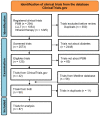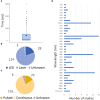Diabetes in spotlight: current knowledge and perspectives of photobiomodulation utilization
- PMID: 38567306
- PMCID: PMC10985212
- DOI: 10.3389/fendo.2024.1303638
Diabetes in spotlight: current knowledge and perspectives of photobiomodulation utilization
Abstract
Introduction: Diabetes is a global health concern characterized by chronic hyperglycemia resulting from insulinopenia and/or insulin resistance. The rising prevalence of diabetes and its associated complications (ulcers, periodontitis, healing of bone defect, neuropathy, retinopathy, cardiopathy and nephropathy) necessitate innovative therapeutic approaches. Photobiomodulation (PBM), involves exposing tissues and cells to low-energy light radiation, leading to biological effects, largely via mitochondrial activation.
Methods: This review evaluates preclinical and clinical studies exploring the potential of PBM in diabetes and its complications, as well all clinical trials, both planned and completed, available on ClinicalTrials database.
Results: This review highlights the variability in PBM parameters across studies, hindering consensus on optimal protocols. Standardization of treatment parameters and rigorous clinical trials are needed to unlock PBM's full therapeutic potential. 87 clinical trials were identified that investigated PBM in diabetes mellitus (with 5,837 patients planned to be treated with PBM). Clinical trials assessing PBM effects on diabetic neuropathy revealed pain reduction and potential quality of life improvement. Studies focusing on wound healing indicated encouraging results, with PBM enhancing angiogenesis, fibroblast proliferation, and collagen density. PBM's impact on diabetic retinopathy remains inconclusive however, requiring further investigation. In glycemic control, PBM exhibits positive effects on metabolic parameters, including glucose tolerance and insulin resistance.
Conclusion: Clinical studies have reported PBM-induced reductions in fasting and postprandial glycemia without an increased hypoglycemic risk. This impact of PBM may be related to its effects on the beta cells and islets in the pancreas. Notwithstanding challenges, PBM emerges as a promising adjunctive therapy for managing diabetic neuropathy, wound healing, and glycemic control. Further investigation into its impact on diabetic retinopathy and muscle recovery is warranted.
Keywords: diabetes; glycemic control; neuropathy; periodontitis; photobiomodulation; retinopathy; wound healing.
Copyright © 2024 Perrier, Moro and Lablanche.
Conflict of interest statement
The authors declare that the research was conducted in the absence of any commercial or financial relationships that could be construed as a potential conflict of interest.
Figures



Similar articles
-
Long-term safety of photobiomodulation exposure to beta cell line and rat islets in vitro and in vivo.Sci Rep. 2024 Nov 6;14(1):26874. doi: 10.1038/s41598-024-77660-8. Sci Rep. 2024. PMID: 39505966 Free PMC article.
-
Photobiomodulation for diabetes and its complications: a review of general presentation, mechanisms and efficacy.Ann Med. 2024 Dec;56(1):2433684. doi: 10.1080/07853890.2024.2433684. Epub 2024 Nov 28. Ann Med. 2024. PMID: 39607829 Free PMC article. Review.
-
Therapeutic Potential of Photobiomodulation in Diabetic Complications.Discov Med. 2024 Oct;36(189):1987-1997. doi: 10.24976/Discov.Med.202436189.183. Discov Med. 2024. PMID: 39463219 Review.
-
Photobiomodulation in diabetic rats: Effects on morphological, pancreatic parameters, and glucose homeostasis.J Biophotonics. 2023 Nov;16(11):e202300182. doi: 10.1002/jbio.202300182. Epub 2023 Aug 22. J Biophotonics. 2023. PMID: 37528614 Review.
-
Preclinical and clinical studies of photobiomodulation therapy for macular oedema.Diabetologia. 2020 Sep;63(9):1900-1915. doi: 10.1007/s00125-020-05189-2. Epub 2020 Jul 14. Diabetologia. 2020. PMID: 32661752 Clinical Trial.
Cited by
-
Effectiveness of Photobiomodulation Versus Local Drug Delivery as an Adjunct to Non-surgical Periodontal Therapy in the Management of Periodontal Pockets: A Case Report.Cureus. 2024 Sep 5;16(9):e68719. doi: 10.7759/cureus.68719. eCollection 2024 Sep. Cureus. 2024. PMID: 39371876 Free PMC article.
-
Long-term safety of photobiomodulation exposure to beta cell line and rat islets in vitro and in vivo.Sci Rep. 2024 Nov 6;14(1):26874. doi: 10.1038/s41598-024-77660-8. Sci Rep. 2024. PMID: 39505966 Free PMC article.
-
Insight of the interrelationship and association mechanism between periodontitis and diabetes mellitus.Regen Ther. 2024 Nov 20;26:1159-1167. doi: 10.1016/j.reth.2024.11.001. eCollection 2024 Jun. Regen Ther. 2024. PMID: 39640921 Free PMC article. Review.
-
Efficacy of indirect intense pulsed light irradiation on meibomian gland dysfunction: a randomized controlled study.Int J Ophthalmol. 2024 Nov 18;17(11):2014-2022. doi: 10.18240/ijo.2024.11.06. eCollection 2024. Int J Ophthalmol. 2024. PMID: 39559304 Free PMC article.
-
Evaluation of Pain and Anxiety Levels After Periodontal Treatment.Medicina (Kaunas). 2025 Mar 7;61(3):464. doi: 10.3390/medicina61030464. Medicina (Kaunas). 2025. PMID: 40142275 Free PMC article.
References
-
- IDF - diabetes atlas (2021). Available at: https://diabetesatlas.org/idfawp/resource-files/2021/07/IDF_Atlas_10th_E....
Publication types
MeSH terms
LinkOut - more resources
Full Text Sources
Medical

